Functionalized Graphene Oxide: Properties & Applications
Reza Hajian1, Kandace Fung1,2, Peichi Peggy Chou1,3, Sike Wang1,2, Sarah Balderston1, Kiana Aran1
1Claremont University, Keck Graduate Institute, School of Applied Life Sciences Claremont, CA 91711, USA, 2Keck Science Department, Claremont McKenna College, Claremont, CA, 91711, USA, 3Keck Science Department, Pitzer College, Claremont, CA, 91711, USA
Material Matters, 2019, 14.1
Article Sections
- Introduction
- Graphene Oxide Applications Using Hydroxyl (OH) Functionalization
- Graphene Oxide Applications Using Epoxy Group Functionalization
- Applications of Graphene Oxide Using Carboxylic Group Functionalization
- Applications of Graphene Oxide Using π-π Stacking Functionalization
- Conclusion
Introduction
The growing interest in the development of new types of implantable and wearable electrochemical sensors for use in medical applications has helped to drive the development of graphene and other new materials. Graphene, discovered in 2004, is a carbon-based nanomaterial that takes the form of an sp2 carbon sheet, with the atoms arranged in a honeycomb lattice,1,2 It has high intrinsic mobility, unrivaled malleability and impermeability, high theoretical specific surface area (2630 m2/g for a single layer), and remarkable electron transport capabilities. Because of the properties imparted by its 2D structure, graphene becomes highly sensitive and selective when functionalized with a linker molecule, making it a promising candidate for a multitude of biosensing applications.3-5
Graphene can take many forms, each with its own characteristics: few-layer graphene (FLG),6 multi-layer graphene (MLG),7 graphene nanoplatelets (GNP),8 graphene oxide (GO),10-12 and reduced graphene oxide (rGO).9 FLG is used in sensors, batteries, and nanoelectronics devices, while both MLG and GNP are known for their applications as conductive inks, plastics additives, and lubricants. rGO is similar to GO, but it possesses a reduced oxygen-carbon ratio making it especially suitable for various chemical and biosensing applications.
Graphene oxide is usually produced by the Hummers method,10 which is easy and inexpensive. GO continues to generate high levels of interest among nanomaterials researchers because of its high conductivity after reduction, selectivity after functionalization, and sensitivity. This review focuses on GO, its functionalization methods, and its many applications.
Graphene oxide is comprised of a single layer graphene sheet, covalently bonded to oxygen functional groups on the basal planes and edges of the sheet. On the basal planes, there are both hydroxyl and epoxy groups; the edges can include carboxyl, carbonyl, phenol, lactone, and quinone groups.11-14 These oxygenated functional groups bind covalently with the carbon atoms in GO, creating oxidized regions of sp3- hybridized carbon atoms that disrupt the non-oxidized regions of the original sp2 honeycomb network. Graphene sheets alone have limited solubility in water due to the strong π-π bonds between layers, so GO or rGO are usually used for biosensing applications.15 The functional groups present on GO are polar, making it very hydrophilic and water-soluble, which is important for processing and chemical derivatization. On the other hand, these oxygen-based functional groups can degrade the electronic, mechanical, and electrochemical properties of GO by creating significant structural defects, reducing electrical conductivity, and potentially limiting its direct application in electrically active materials and devices. However, GO can instead be functionalized by partially reducing it to rGO with various chemical or thermal treatments,15 in order to facilitate the transport of carriers.16 This chemical modification decreases its resistance by several orders of magnitude17 and transforms the material into a graphene-like, semiconducting material.
Chemical functionalization is an easy way to modify GO, and has proven extremely useful for creating sensors for biomedical, electrochemical, and diagnostic applications. The reactive and modifiable oxygenated functional groups of GO can be functionalized with different electroactive species.18 This covalent functionalization of specific molecules can mitigate the non-specific binding that typically occurs with plain graphene sensors. Many methods have been developed to minimize the disadvantages of GO while enhancing the advantages of graphene qualities.1 For example, covalently bonding different chemical linkers to GO can modify the surface of the graphene and fine-tune its properties. Careful functionalization of GO increases its conductivity, stability, and selectivity for electrochemical sensing applications,1,2,18 as well as enhancing its sensitivity by increasing the surface area.
Applications of Functionalized Graphene Oxide
Graphene Oxide Applications Using Hydroxyl (OH) Functionalization
Hydroxyl groups attached to the basal planes of GO sheets can be effective attachment sites for different chemical agents. For example, the surface can be modified by silanization, a process that coats a surface with organofunctional alkoxysilane molecules. This modification technique has been shown to produce carbon nanomaterials with optimal chemical and physical properties for fabricating conducting films.19-21
Designing nanomaterials that have strong metal adsorption and antimicrobial capabilities for environmental,23,24 catalytic,25-27 and biomedical applications28 has posed a challenge. In 2014, Carpio et al. conducted experiments on GO functionalization using ethylenediamine triacetic acid (EDTA), a strong chelating agent, to enhance the multi-functionality of GO, thus increasing its metal adsorption and antimicrobial properties.22 In this study, GO was functionalized with N-(trimethoxysilylpropyl) ethylenediamine triacetic acid (EDTA-silane). In a dehydrationcondensation reaction, the hydrolysis of the trialkoxy groups in Si-EDTA creates -Si-OH groups that interact with the hydroxyl groups (OH-C) to form Si-O-C bonds. When compared to GO, GO-EDTA demonstrates improved antimicrobial characteristics with a 10.1% and 7.1% increase in cell inactivation of B. subtilis (Gram-positive) and C. metallidurans (Gram-negative), respectively. GO-EDTA also demonstrates maximum adsorption capacities for Cu2+ and Pb2+ that exceeds the capacities of traditional adsorbent materials. In addition, after 24-hour exposure to human corneal epithelial cell lines, GO-EDTA shows minimal toxicity on human cells, as 99% of the cell culture remained viable. This makes GO-EDTA a promising carbon nanomaterial for future clinical applications.
Another study used EDTA to functionalize rGO, by creating a rGO-EDTA composite suspended in Nafion-ethanol solution.29 The rGO-EDTA/Nafion film was then deposited onto a glassy carbon (GC) electrode, and this rGO-EDTA device could detect dopamine (DA) via oxidation.
Hu et al. investigated silanization, reduction, silanization combined with reduction, and in situ co-polymerization as methods for functionalizing GO, in order to improve tensile strength and solubility.30 The hydroxyl groups on graphene oxide and rGO sheets were silanized with 3-methacryloxypropyltrimethoxysilane (MPS, Cat. No. 440159)34 (Figure 1). Water suspension tests for GO, rGO, MPS-GO, and MPS-rGO revealed that MPS-GO and MPS-rGO had enhanced water solubility. Hu et al. then functionalized GO and rGO derivatives with poly(methyl methacrylate) (Cat. Nos. 182230, 200336, 445746, and 182265, PMMA) via in situ co-polymerization in order to increase the mechanical properties of the polymer. The MPS-rGO/PMMA composites had 30% more tensile strength when compared to pristine PMMA due to the stable dispersion of the nanosheets in the polymer matrix that increased the interfacial strength indicating potential for future industrial applications.30
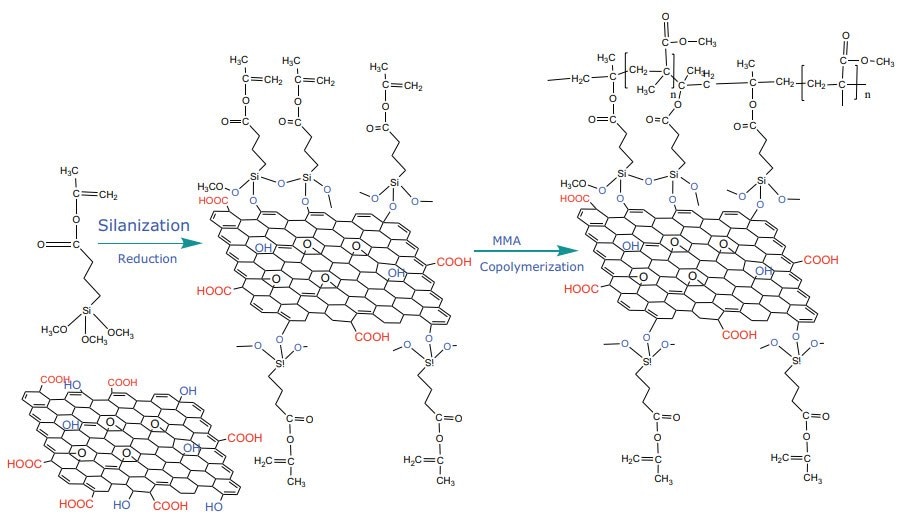
Figure 1.Silanization of GO using MPS, following co-polymerization of functionalized, silanized-GO with PMMA. Reproduced with permission from reference 30, copyright 2014 Elsevier.
Instead of silanization, hydroxyl groups on GO can also be functionalized by esterification. In one study, this functionalization occurred through a reaction with nitriles and then separation of the products through filtration and/or centrifugation.31 Yuan et al. demonstrated that GO functionalized with poly(l-lactic) acid (Cat. Nos. 764590, 764698, 765112, 900295, etc., PLLA) improved its properties including tensile strength, tensile fracture strength, and dispersibility.32
In 2010, GO was functionalized via esterification to synthesize a GO framework for gas adsorption.33 The researchers combined GO with benzene-1,4-diboronic acid (B14DBA, Cat. No. 417130) to form boronic esters (Figure 2). In this case, single layer GO sheets were crosslinked together, building a 3D porous network connected by benzenediboronic acid pillars. The framework structures had modifiable pore widths, volumes, and binding sites, making them extremely useful for gas storage.
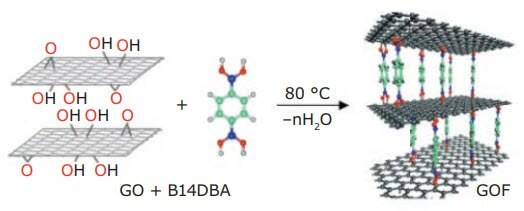
Figure 2.GO sheets functionalized with B14DBA via covalent bonding of -OH groups to create GOF. Reproduced with permission from reference 33, copyright 2010 John Wiley and Sons.
Graphene Oxide Applications Using Epoxy Group Functionalization
Covalent functionalization of graphene oxide through modification of epoxy groups on the basal planes usually involves a nucleophilic attack at the α-carbon of the epoxide, and using an amine group to catalyze the ring-opening reaction. For example, in 2008 Wang et al. used octadecylamine (ODA, Cat. No. 74750) as the nucleophile, thus opening the rings and creating polydispersed, chemically converted graphene oxide sheets (p-CCG).34 This method produced GO as colloidal suspensions in organic solvents that could then be spin-coated, printed onto various substrates, or fully reduced into high quality chemically modified graphene (CMG) films. These new properties make p-CCGs highly promising starting material for electrochemical sensors.
A similar study was conducted by Yang et al. using 1-(3-aminopropyl)-3-methylimidazolium bromide (R-NH2), an ionic liquid, to functionalize GO by the same ring-opening mechanism (Figure 3).35 The p-CCGs produced had excellent solution-stability in polar solvents.35 Likewise, these p-CCGs demonstrate potential for electrochemical applications, for example for chemically-modified electrodes.
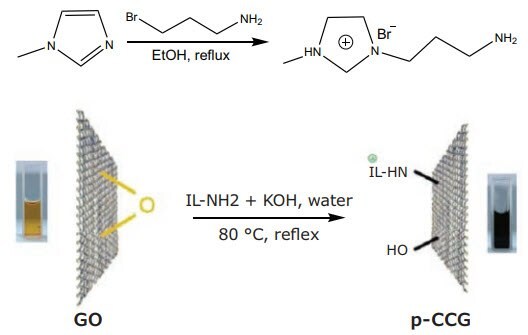
Figure 3.GO functionalized to prepare p-CCG. Reproduced with permission from reference 35, copyright 2009 Royal Society of Chemistry.
In 2015, Bandyopadhya et al. synthesized hexylaminefunctionalized rGO (rGO-HA)36 by a nucleophilic addition of the HA amine groups onto the GO epoxy groups. Hydrazine hydrate (Cat. Nos. 18412, 225819) was then added to reduce the composite to the final rGO-HA product. This alkylamine functionalization resulted in the enhanced hydrophobicity of the rGO-HA sheets and allowed them to be well-dispersed in various organic solvents. The permeability of hydrogen gas into a synthesized rGO-HA film after coating on the surface of polyurethane (PU) decreased, suggesting a potential use in industrial hydrogen gas separation and purification.36
Another group used 3-aminopropyltriethoxysilane (APTS, Cat. No. 440140) to functionalize graphene oxide platelets via an SN2 reaction between the epoxide and APTS amine groups.37 The researchers were able to synthesize polydispersed, functionalized, and chemically converted graphene (f-CCG) that was soluble in many polar media. Due to its increased strength, the functionalized-GO product has applications as both bio-encapsulation and sensors, among other uses.
Shams et al. synthesized a nanocomposite of GO and ethylenediamine (EDA, Cat. No. E26266) under reflux at 50 °C for use as an electrochemical sensor to detect fenitrothion in natural water.38 In addition, EDA was used to crosslink GO and gold nanoparticles (AuNPs) in order to increase the hydrophilicity and dispersibility of GO in polar solvents with a decreased tendency to aggregate.1
Applications of Graphene Oxide Using Carboxylic Group Functionalization
Similar to hydroxyl and epoxy groups, carboxyl groups can be functionalized through activation and amidation or esterification with small molecules or polymer chemical linkers.40-43 In one study, graphene oxide was activated with N,N’-Dicyclohexylcarbodiimide (DCC, Cat. No. D80002) and coupled with an esterification reaction using an allotropic carbon nanomaterial, fullerenol (C60, Cat. No. 379646).58 Like other allotropic carbon nanomaterials, C60 possesses superconductivity, photoconductivity, and nonlinear optical (NLO) properties. In another study, Zhang et al. synthesized a graphene-C60 hybrid and investigated the NLO properties of this hybrid.39 They found that the hydroxyl groups of fullerene formed covalent ester bonds with the carboxylic groups on GO (Figure 4). Liu et al. also reported GO functionalization with another allotropic carbon material, porphyrin (TPP-NH2). In this case, the carboxylic groups of GO bonded to the amine group on TPP-NH2 via activation coupled with amidation instead of esterification.44 The GO-hybrids exhibited great potential for application as optical limiting and optical switching materials for optoelectronic and photonic devices.
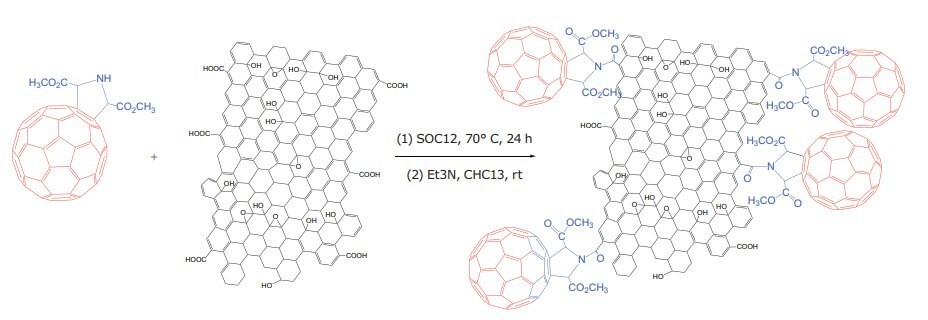
Figure 4.Scheme of fullerenol functionalizing GO via ester linkages. Reproduced with permission from the corresponding author.39
Su et al. described a method of fabricating diaminefunctionalized GO films through covalent bonding with the -COOH groups on the GO sheets.45 Using a well-established procedure, N-(3-dimethylaminopropyl)-N’-ethylcarbodiimide hydrochloride (EDC, Cat. No. 03449) and N-hydroxysuccinimide (NHS, Cat. No. 130672) served as coupling reagents.45 Novel impedance-type humidity sensors were made by coating diamine-functionalized GO films onto alumina or plastic substrates. These sensors, comprised from the diamine-functionalized GO film, worked across a wide humidity range, and exhibited a high sensitivity, high flexibility, high long-term stability, satisfactory linearity, a small hysteresis, a short response/recovery time, and only a weak dependence on temperature.
Other studies of esterification include grafting epoxy chains onto graphene oxide sheets via ester linkages with the carboxyl groups on GO, which can enhance the mechanical and thermal properties of graphene oxide while also increasing interfacial interactions.63 This type of functionalized GO also can be used to create polymer solar cells (PSCs).
Cesium-neutralized GO (GO-Cs) has been used to transform GO into an electron extraction layer (EEL) in polymer solar cells (PSC).46 Cesium carbonate (Cs2CO3 , Cat. Nos. 202126, 441902, 554855, 255645) was introduced to GO, resulting in neutralization of the -COOH groups to -COOCs groups. This product demonstrated promise as an excellent electron-extraction layer in solar cell devices.
Graphene oxide has also been functionalized with biomolecules. For example, in 2010, Shen et al. functionalized GO with bovine serum albumin (BSA) via diimide-activated amidation, a popular method for connecting proteins to other materials.47 This process resulted in a GO-BSA conjugate, with no evidence of protein denaturation. Cyclic voltammogram (CV) measurements indicated that the conjugate maintained bioactivity and exhibited excellent water solubility, making it suitable for interaction with biological substrates.
The application of GO as a biosensor for clinical diagnosis was investigated by functionalizing carboxylic groups of GO with glucose oxidase (GOx), thus producing a biocompatible GO-GOx biosensor.53 In this study, a cell line derived from human retinal pigment epithelium (RPE), a neuroectodermal derivative that is vital for photoreceptor survival, was introduced onto GO-GOx. The complex demonstrated excellent biocompatibility. The GO-based glucose biosensors exhibited a broad linear range, good stability, high sensitivity, excellent reproducibility, and great biocompatibility to human RPE cells, suggesting that these biosensors have tremendous potential for use in in vivo clinical diagnostics, such as diabetic retinopathy. The functionalization of GO’s carboxyl groups also demonstrated GO’s promise in creating enzyme electrodes that can be used in biomedicine and clinical diagnostics.
Yagati et al. reported an electrochemical sensor based on electrochemical co-reduction of graphene oxide/nanoparticle (ERGO-NP) composite films by the chronoamperometry method on indium tin oxide (ITO) electrodes, which was then utilized to sense H2O2 by direct electron transfer by horseradish peroxidase (HRP).48 Covalent bonding between the amine groups of the enzyme and the carboxylate terminal of rGO and nanoparticles activated with 3-mercaptopropionic acid (Cat. No. M5801) was achieved through EDC/NHS coupling, leading to the formation of strong amide bonds (Figure 5).
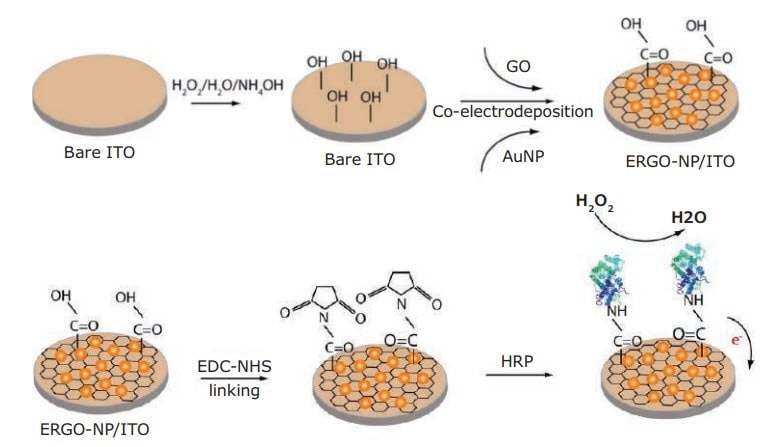
Figure 5.Schematic diagram depicting the surface functionalization of the formation of the HRP/ERGO-NP/ITO modified electrode applied for detection of H2O2 . Reproduced with permission from reference 48, copyright 2014 Electrochemical Society.
In another study, graphene oxide was functionalized by the coupled reactions of EDC activation and polyethylene glycol (PEG) amidation.49 The PEG-GO nanosheet products had excellent aqueous solubility and stability in biological solutions, including serum. Liu et al. then used the functionalized GO derivative to create a complex with various insoluble, aromatic camptothecin analogues, showing the potential of functionalized GO to deliver water-insoluble cancer drugs.
In 2008, Mohante and Berry investigated two approaches for covalent functionalization of GO via activation coupled with amidation. The resulting chemically modified graphene (CMG) demonstrated potential application in improving the nano/ bio interface for biodetection, bioactuation, and diagnostics.50 Electrical characterization of the GO-derivatives showed that the graphene-DNA (G-DNA) hybrid had a 128% increase in conductivity due to DNA’s negative charge on the p-type GO, while the hybridization of G-DNA with cDNA generated approximately a single quantum of conducting hole, increasing conductivity by 71%.51
In another study, Liu et al. investigated the possibilities of functionalized GO as a selective and sensitive hybridized DNA biosensor.43 GO was activated with EDC/sulfo-NHS, using similar chemistry to EDC/NHS described above, which converts the carboxylic groups of GO into their amine-reactive NHS-ester forms. The functionalized carboxylic groups bound to aminomodified ssDNA, which allowed a complementary ssDNA labeled with gold nanoparticles (AuNPs) to attach to the GO-DNA probe in a hybridization reaction.
Applications of Graphene Oxide Using π-π Stacking Functionalization
The excellent adsorption of organic aromatic molecules on GO nanosheets can be attributed to both π-π stacking and hydrophobic interactions between GO and other aromatic molecules. In the past, studies have shown that the incorporation of sulfonic acid onto the surface of GO sheets can significantly increase its proton conductivity.52-54 Su et al. used 3,4,9,10-perylenetetracarboxylic diimide bis-benzene sulfonic acid (PDI), a large planar aromatic electron acceptor, and pyrene-1- sulfonic acid (PyS), a larger, planar aromatic electronic donor, to non-covalently functionalize rGO.55 PyS and PDI molecules with negative charges were able to strongly affix onto the hydrophobic surface of graphene sheets via π-π interactions, without disrupting its electronic conjugation. This produced rGO-based composites with modifiable electronic properties that could be utilized to produce electronic devices.
In order to prepare water soluble CMG sheets for excellent stable-dispersion in polar solvents with enhanced conductivity, GO was reduced and at the same time non-covalently functionalized with 1-pyrenebutyrate (PB- ), also using π-π interactions.19 Here, PB- acted as a stabilizer during the transformation of GO to rGO, as the aromatic pyrene undergoes π-π stacking with the basal plane of rGO. The resulted rGO-PBwas able to form homogenous dispersion in water, and films cast from this dispersion were seven times more conductive than that from non-functionalized GO dispersions.
In order to take advantage of the selectivity and sensitivity of GO-based biosensors, Lu et al. non-covalently functionalized GO with aromatic compounds and nucleobases, resulting in a GO platform that could detect both DNA and proteins.56 Immobilizing the dye-labeled ssDNA with great affinity to GO via π-π interactions,49,57 caused quenching of the dye fluorescence.80 Subsequent binding of the dye-labeled ssDNA and the target molecule resulted in a conformational change of the dyelabeled DNA, interfering with its interactions with and releasing it from GO, which led to the reappearance of the fluorescence signal. This proof of concept study confirmed the possibility of developing a fluorescence-enhanced GO-based device with sensitive and selective detection for a target molecule.
A similar study used the same quenching effect of GO with hairpin-structured DNA to produce a GO-based molecular beacon (MB) — a single-stranded oligonucleotide hybridization probe to recognize a target analyte with a complimentary probe sequence. This approach demonstrated stronger affinity of DNA for GO and sensitive and selective detection of specific DNA sequences.58 Dong et al. fabricated a GO-based platform to detect biomolecules using fluorescence resonance energy transfer (FRET) from quantum dots (QDs) (with a MB) to GO.59 The QDs, modified with a MB (MB-QDs), were able to act as probes on GO, thus allowing the recognition of specific DNA sequences. The strong π-π stacking interactions between MB-QDs and GO resulted in quenching of the QDs fluorescence. In the presence of the DNA target, the distance between QDs and GO increased, weakening the GO MB-target interactions and thus significantly decreasing the FRET and increasing the QDs fluorescence intensity, indicating a facile method for target recognition.
Wang et al. described a method for functionalization of GO with polyaniline (PANI) via electrostatic interactions, hydrogen bonding, and π-π stacking interactions.60,61 The GO-PANI composites were further optimized via in situ polymerization of monomer in the presence of GO, using a mild oxidant, thus improving the electrochemical performance of the composite as a supercapacitor electrode. The composites had increased initial specific capacitances, improved capacitance retention, and decreased internal resistance, when compared to a PANI electrode alone.
Graphene oxide has also been functionalized with TPE-SO3Na via π-π stacking to improve the selectivity of biosensors based on aggregation-induced emission (AIE) for detection of bovine serum albumin (BSA).62 In AIE biosensors, non-luminescent molecules are induced to emit efficiently by aggregate formation.63-65 TPE-SO3Na is an AIE molecule that can detect bio-macromolecules such as BSA.66 The binding of BSA prevents the free rotation of the AIE molecule, making TPE-SO3Na highly emissive in its presence.67 While TPE-SO3Na is highly sensitive for BSA, it displays no selectivity for BSA, as it responds similarly to many other bio-macromolecules.66,67 However, with the addition of GO, the detection of BSA with good sensitivity and selectivity can be achieved.71 This is because the π-π interactions between the AIE molecule and GO quench fluorescence, but only when the binding effect of AIE molecules and the protein is stronger than the π-π interaction. Since the binding effect of TPE–SO3Na for BSA is slightly higher than other proteins, selectivity was achieved.
Due to the resulting strength of the π-π interactions, functionalization of graphene surfaces with pyrene (PY) derivatives has also been studied. In 2018, Wang et al. investigated functionalization of thermally reduced GO (trGO) with pyrene derivatives, terminated by the hydrogen bonding unit ureidopyrimidinone (UP) to form (trGO)-UPPY.68 The graphene surface was modified with pyrene groups which formed π-π bonds with UPPY (Figure 6). This Layer-by-Layer (LBL) selfassembly technique was repeated to form films of trGO-UPPY that compose both hydrogen bonds and π-π bonds. The resulted multilayer films demonstrated potential as excellent electron conductors to improve electron transfer.
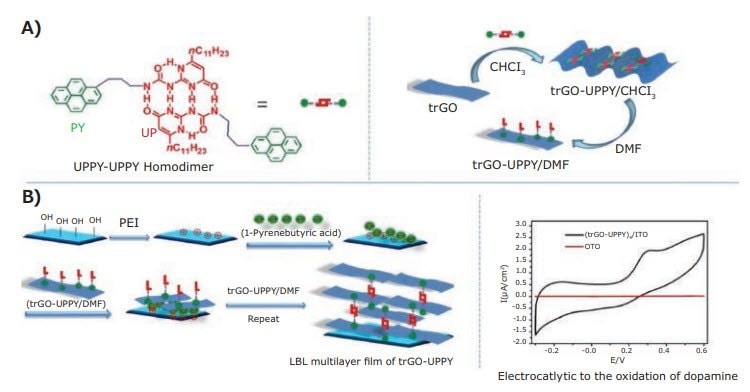
Figure 6. A) Formation of UPPY-UPPY homodimer B) Grafting of UPPY onto trGO through π–π bonding and formation of multilayer trGO-UPPY through LBL assembly technique. Reproduced with permission from the corresponding author.68
In another biomedical study, Wahid et al. examined GO as a potential drug carrier through non-covalent functionalization.74 Aromatic organic molecules (drugs) that were non-covalently attached to graphene surfaces were more easily released than those bonded covalently. Wahid et al. also reported the successful functionalization of graphene sheets with Ramizol, an antibiotic with antioxidant properties.69 Due to its planar geometry, Ramizol can form π-π bonds with graphene surfaces; this interaction has been previously shown to facilitate the exfoliation of graphite into graphene sheets, while stabilizing the sheets in aqueous environments.
Another method for noncovalent functionalization of GO was demonstrated by Liu et al. using a redox reaction.70 This spontaneous redox reaction occurs in an aqueous mixture containing GO, FeCl3 , and K3 [Fe(CN)6 ], resulting in the formation of Prussian blue (PB) nanocubes on the surface of GO. This GO-PB nanocomposite was cast onto a GC electrode surface, demonstrating great stability, good reproducibility, excellent electrochemical activity, and high sensitivity for electrocatalytic reduction of H2O2 . In addition, GO increased the effective surface area of the GC electrode, thus enhancing sensitivity. This GO-PB nanocomposite showed great promise as a potential biofuel cell electrode, as well as a novel electrochemical sensor.
Conclusion
Graphene oxide sheets are carbon-based nanomaterials with hydroxyl, epoxy, carboxyl, and other functional groups attached to their basal planes and edges. Various functionalization methods have been used to enhance their mechanical, electrical, and chemical properties. For functionalization of hydroxyl groups, silanization on GO and rGO with molecules such as MPS can improve both tensile strength and solubility. In addition, esterification with benzene-1,4-diboronic acid can link multiple single layer GO sheets into a 3D porous network. For covalent functionalization of epoxy groups on GO, many methods involve attack on the α-carbon of the epoxide, thus creating nanosheets with high dispersibility in polar solvents and films with enhanced gas barrier properties. For the functionalization of carboxylic groups, some common methods include activation coupled with esterification, which solubilizes GO; other methods include activation coupled with amidation, which facilitates attachment of common biomolecules to GO. The ability to enhance its properties demonstrates the wide range of GO’s potential applications, especially in the field of biomedicine, water-insoluble drug delivery, clinical diagnostics, and specific DNA sequence detection. For non-covalent functionalization, π-π stacking and electrostatic interactions enhance the electrical properties of GO, improving the electron transfer process, increasing the specific capacitance, and decreasing the internal resistance. Non-covalent functionalization of GO has improved as an effective and tunable approach for fabricating electrochemical sensors and selective biomolecule detectors. In summary, modified graphene oxide sheets are now being widely applied in the development of devices for use in fields of industrial, environmental, and biomedical research, and their full potential is only beginning to be developed.
Materials
References
To continue reading please sign in or create an account.
Don't Have An Account?